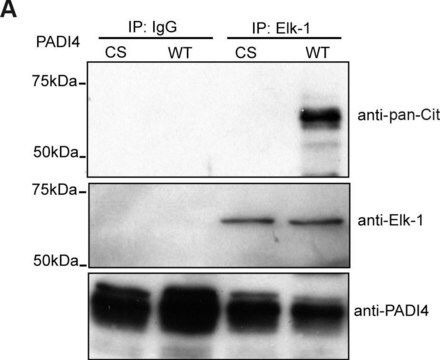FCABS400F
Milli-Mark® Anti-FcεRI Antibody, γ subunit-FITC
Milli-Mark®, from rabbit
Synonim(y):
Fc fragment of IgE high affinity I receptor for gamma polypeptide, Fc-epsilon RI-gamma, FceRI gamma, IgE Fc receptor subunit gamma, Immunoglobulin E receptor, high affinity,gamma chain
About This Item
Polecane produkty
pochodzenie biologiczne
rabbit
Poziom jakości
białko sprzężone
FITC conjugate
forma przeciwciała
purified immunoglobulin
rodzaj przeciwciała
primary antibodies
klon
polyclonal
reaktywność gatunkowa
mouse, human, rat
producent / nazwa handlowa
Milli-Mark®
metody
flow cytometry: suitable
izotyp
IgG
numer dostępu NCBI
numer dostępu UniProt
Warunki transportu
wet ice
docelowa modyfikacja potranslacyjna
unmodified
informacje o genach
human ... FCER1G(2207)
Opis ogólny
Specyficzność
Immunogen
Zastosowanie
Inflammation & Immunology
Inflammation & Autoimmune Mechanisms
Jakość
Opis wartości docelowych
Postać fizyczna
Przechowywanie i stabilność
Komentarz do analizy
RBL cells
Inne uwagi
Informacje prawne
Oświadczenie o zrzeczeniu się odpowiedzialności
Nie możesz znaleźć właściwego produktu?
Wypróbuj nasz Narzędzie selektora produktów.
Kod klasy składowania
12 - Non Combustible Liquids
Klasa zagrożenia wodnego (WGK)
WGK 2
Temperatura zapłonu (°F)
Not applicable
Temperatura zapłonu (°C)
Not applicable
Certyfikaty analizy (CoA)
Poszukaj Certyfikaty analizy (CoA), wpisując numer partii/serii produktów. Numery serii i partii można znaleźć na etykiecie produktu po słowach „seria” lub „partia”.
Masz już ten produkt?
Dokumenty związane z niedawno zakupionymi produktami zostały zamieszczone w Bibliotece dokumentów.
Produkty
Końcówki do wyboru barwników do cytometrii przepływowej dopasowują fluorofory do konfiguracji cytometru przepływowego, zwiększając wydajność panelu.
Protokoły
Zapoznaj się z naszym przewodnikiem po cytometrii przepływowej, aby odkryć podstawy cytometrii przepływowej, tradycyjne komponenty cytometru przepływowego, kluczowe etapy protokołu cytometrii przepływowej i odpowiednie kontrole.
Nasz zespół naukowców ma doświadczenie we wszystkich obszarach badań, w tym w naukach przyrodniczych, materiałoznawstwie, syntezie chemicznej, chromatografii, analityce i wielu innych dziedzinach.
Skontaktuj się z zespołem ds. pomocy technicznej








